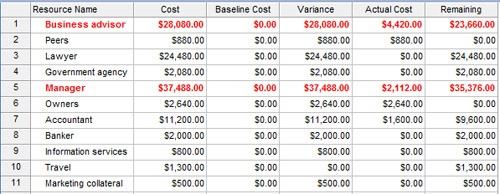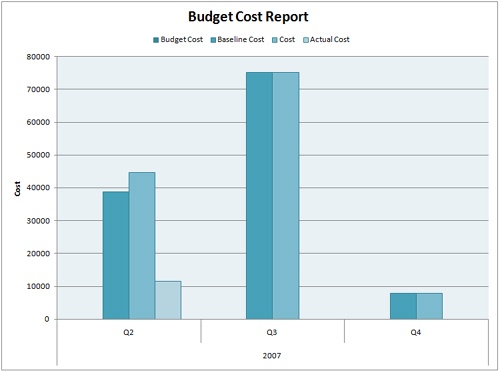If your project is primarily constrained by budget, you’ll want to keep a close eye on the resource and task costs, and on estimated costs for the project as a whole. You’ll also want to adjust your project plan if you receive any actuals that are likely to blow the budget.
Use one or more of the following techniques to monitor and adjust costs so you can continue to work within your budget:
Display specialized views and tables to review project costs.
Adjust the schedule to reduce costs.
Adjust assignments to reduce costs.
Note
For more information about monitoring and adjusting costs to achieve a specific budget, see the section titled Reducing Project Costs in Chapter 9.
Using baseline information you saved, you can review your current costs and compare them with baseline costs. For example, you can see baseline costs for tasks (including their resource costs) next to their scheduled costs, based on actuals you entered. Then, you can review the variances between the baseline and scheduled cost. The cost variance is calculated as follows:
(Scheduled/Current) Cost – Baseline Cost = Cost Variance
Note
You can use earned value calculations, such as the Budgeted Cost of Work Scheduled (BCWS) and Cost Variance (CV) earned value fields to analyze your project performance against the budget so far.
For more information, see the section titled Generating Earned Value Data in Chapter 13.
There are two ways to review your overall cost totals, as follows:
Review project statistics. Click Project, Project Information and then click the Statistics button. Under Cost, review the current, baseline, actual, and remaining cost for the project. You can also click Project Statistics on the Tracking toolbar.
Add the project summary task row. In the Gantt Chart or other task sheet, click Tools, Options and then click the View tab. Select the Show Project Summary Task check box. Summary totals for task information in the current table are displayed in the project summary task row at the top of the sheet. If a table containing cost information is applied, the project summary task row shows project cost totals.
Use the Cost table to review the differences between your original baseline costs and your currently scheduled costs. The Cost table includes fields containing baseline costs, total scheduled costs, actual costs, remaining costs, and cost variances. To apply the Cost table, follow these steps:
Display the Gantt Chart or other task sheet.
Click View, Table, Cost.
The Cost table is applied to the current view (see Figure 11-9).
With the project summary task row applied, you can also review rolled up cost totals.
There’s also a cost table for resources, which includes cost information for all a resource’s assignments. With the Resource Sheet or Resource Usage view displayed, apply the Cost table. The Resource Cost table includes the baseline cost, scheduled cost, actual cost, remaining cost, and cost variance for all the resource’s assignments (see Figure 11-10). Cost information is shown for all types of resources—work, material, and cost resources.
You can apply a filter to a task or resource sheet to see only those tasks or resources associated with overbudget costs, as follows:
Display the view and apply the table that contains the information you want to review in the context of overbudget costs.
Click Project, Filtered For, More Filters.
In the More Filters dialog box, click Cost Overbudget and then click Apply.
If you prefer to see all tasks or resources, but have the overbudget tasks or resources highlighted, click Highlight instead.
Microsoft Project filters for any tasks or resources whose scheduled or actual costs are higher than the baseline costs.
Review the tasks or resources to analyze the extent of the cost overages.
When you finish, show all tasks again by clicking the Filter tool on the Formatting toolbar and then clicking All Tasks.
If you set a baseline and are entering actuals, you can evaluate current cost and schedule performance using earned value calculations. To generate most earned value information, you must have the following items in your project plan:
A saved baseline
Resources assigned to tasks
Costs associated with assigned resources
Actual progress information
To review earned value information, follow these steps:
Display the Gantt Chart or other task sheet.
Click View, Table, More Tables.
Click Earned Value, Earned Value Cost Indicators, or Earned Value Schedule Indicators, depending on the type of earned value information you want to review.
The table is applied to the task sheet (see Figure 11-11).
You can see a list of all earned value fields available in Microsoft Project. In the Type A Question For Help box, type fields and then press Enter. Click Earned Value Fields. The list of all available earned value fields appears in a separate Help window.
Click a field name to open a Help topic that gives a description of each field, how it’s calculated, its best uses, and an example of its use.
Table 11-1 lists the default contents of each of the three earned value tables.
Table 11-1. Earned Value Tables
Included fields | |
|---|---|
Earned Value | BCWS (Budgeted Cost of Work Scheduled), also known as Planned Value or PV |
BCWP (Budgeted Cost of Work Performed), also known as Earned Value or EV | |
ACWP (Actual Cost of Work Performed), also sometimes referred to as AC | |
SV (Schedule Variance) | |
CV (Cost Variance) | |
EAC (Estimate At Completion) | |
BAC (Budget At Completion) | |
VAC (Variance At Completion) | |
Earned Value Cost Indicators | BCWS (Budgeted Cost of Work Scheduled), also known as Planned Value or PV |
BCWP (Budgeted Cost of Work Performed), also known as Earned Value or EV | |
CV (Cost Variance) | |
CV% (Cost Variance Percent) | |
CPI (Cost Performance Index) | |
BAC (Budget At Completion) | |
EAC (Estimate At Completion) | |
VAC (Variance At Completion) | |
TCPI (To Complete Performance Index) | |
Earned Value Schedule Indicators | BCWS (Budgeted Cost of Work Scheduled), also known as Planned Value or PV |
BCWP (Budgeted Cost of Work Performed), also known as Earned Value or EV | |
SV (Schedule Variance) | |
SV% (Schedule Variance Percent) | |
SPI (Schedule Performance Index) |
Note
For more information about analyzing project performance with earned value, see the section titled Reviewing Earned Value Data in Chapter 13.
The following filters can help you focus on any potential problems with project costs and budget:
Cost Greater Than (see Figure 11-12)
Cost Overbudget
Late/Overbudget Tasks Assigned To
Work Overbudget
Figure 11-12. The Cost Greater Than filter has been applied to this table to focus on those tasks that have the highest costs.
Apply a filter by clicking the arrow beside the Filter tool on the Formatting toolbar. In the Filter list, click the name of the filter you want. To show all tasks again, in the Filter list, click All Tasks.
You can also run text-based and visual reports that provide information about costs and budget status, as follows:
Cash Flow
Budget
Overbudget Tasks
Overbudget Resources
Earned Value
Baseline Cost Report (visual report in Microsoft Office Excel 2007)
Baseline Report (visual report in Visio)
Budget Cost Report (visual report in Office Excel 2007)
Cash Flow Report (visual reports in Excel or Visio)
Earned Value Over Time Report (visual report in Excel)
Resource Cost Summary (visual report in Excel)
To run a text-based cost report, click Report, Reports. Double-click Costs and then double-click the report you want. If a dialog box asks for more information, enter the information and then click OK. The report appears in a preview window in which you can go on to print the report or study the details (see Figure 11-13).
Figure 11-13. Run the Overbudget Resources report to see which resource costs are greater than the baseline resource costs.
To run a visual report, follow these steps:
The report is generated from Microsoft Project data and displayed in Visio or Excel (see Figure 11-14 for an example of a chart displayed in Excel).
Suppose that you reviewed your budget details against the current project costs and found that you will end up significantly over budget. Or perhaps upper management has asked you to cut costs by 10 percent, and you need to work toward a different total project cost.
If you need to take corrective actions in your project plan to reduce project costs, you can do the following:
Recheck your basic cost assumptions such as resource rates, per-use costs for resources, amounts for cost resources assigned to tasks, and fixed costs for tasks.
Adjust the schedule to reduce costs. Reducing task durations and adjusting task dependencies can help reduce costs.
Adjust assignments to reduce costs. Add, remove, or replace resources on assignments as appropriate to cut costs.
Cut scope to reduce costs (which will probably require stakeholder approval).
When you adjust your project plan to achieve the budget you need, be sure to check your finish date, resource allocation, and scope. You need to know how your changes affect other areas of the project plan.
Note
For more information about using any of these strategies to trim project costs, see the section titled Reducing Project Costs in Chapter 9.
You might also consider setting a new baseline, especially if there have been major cost changes or changes that have affected the schedule.
Note
For more information on setting a new baseline, see the section titled Need a New Baseline? later in this chapter.






